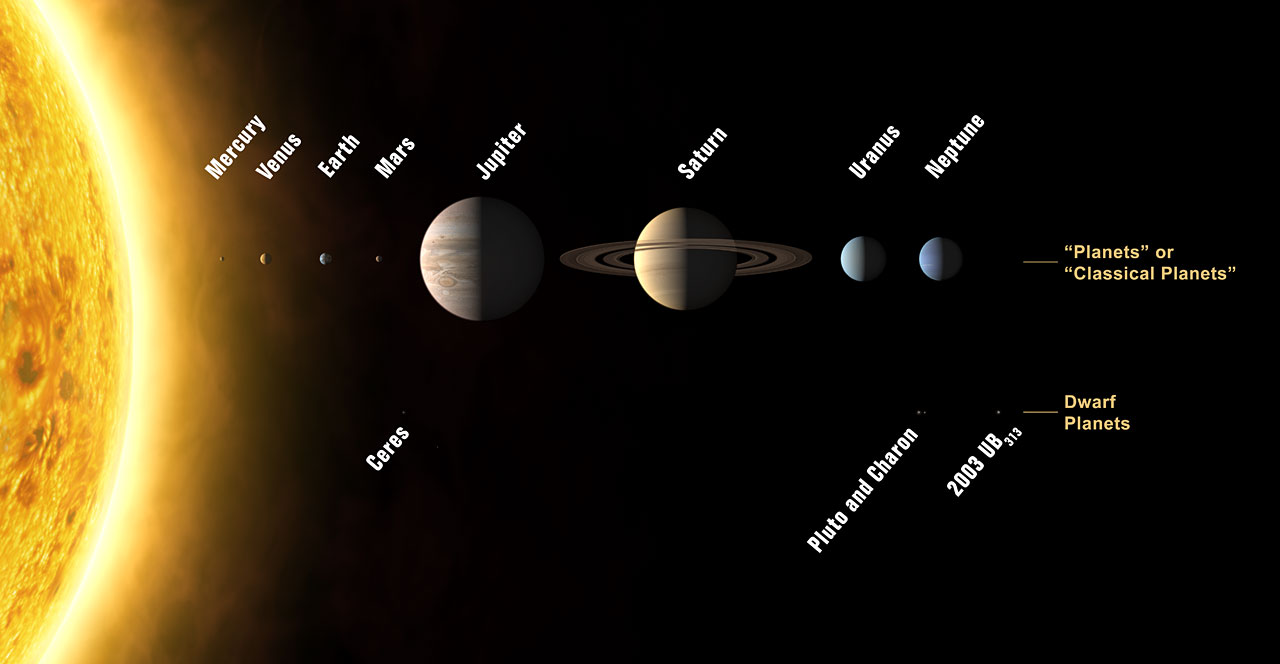Here's the basic history of the naming of the planets:
1) Etymology of the word planet:
late O.E., from O.Fr. planete (Fr. planète), from L.L. planeta, from Gk. (asteres) planetai "wandering (stars)," from planasthai "to wander," of unknown origin. So called because they have apparent motion, unlike the "fixed" stars. Originally including also the moon and sun; modern scientific sense of "world that orbits a star" is from 1640.
2) That "modern scientific sense" is not quite accurate any more. Here are some reasons:
A) Ganymede, one of Jupiter's moons is larger in radius than Mercury by about 200 km.
B) Pluto's orbit is very strange compared with the eight other planets; Pluto sometimes is closer to the sun than Neptune. No, they're not likely ever to hit each other.
C) There are objects outside of Pluto's orbit that are larger than Pluto; should they be called planets? If so, we're going to end up with a few hundred or more planets in our solar system; we'll never come up with a reasonable mnemonic to remember their names. ;)
Here's the resolution by the IAU, the body responsible for naming objects in space:
RESOLUTIONSResolution 5A is the principal definition for the IAU usage of "planet" and related terms.
Resolution 6A creates for IAU usage a new class of objects, for which Pluto is the prototype. The IAU will set up a process to name these objects.
IAU Resolution: Definition of a "Planet" in the Solar System
Contemporary observations are changing our understanding of planetary systems, and it is important that our nomenclature for objects reflect our current understanding. This applies, in particular, to the designation "planets". The word "planet" originally described "wanderers" that were known only as moving lights in the sky. Recent discoveries lead us to create a new definition, which we can make using currently available scientific information.
RESOLUTION 5A
The IAU therefore resolves that planets and other bodies in our Solar System, except satellites, be defined into three distinct categories in the following way:
(1) A "planet" [1] is a celestial body that (a) is in orbit around the Sun, (b) has sufficient mass for its self-gravity to overcome rigid body forces so that it assumes a hydrostatic equilibrium (nearly round) shape, and (c) has cleared the neighbourhood around its orbit.
(2) A "dwarf planet" is a celestial body that (a) is in orbit around the Sun, (b) has sufficient mass for its self-gravity to overcome rigid body forces so that it assumes a hydrostatic equilibrium (nearly round) shape [2], (c) has not cleared the neighbourhood around its orbit, and
(d) is not a satellite.
(3) All other objects [3], except satellites, orbiting the Sun shall be referred to collectively as "Small Solar-System Bodies".
IAU Resolution: Pluto
RESOLUTION 6A
The IAU further resolves:
Pluto is a "dwarf planet" by the above definition and is recognized as the prototype of a new category of trans-Neptunian objects.
So, this is really just taxonomy.
Here's the deal. Nearly every planetary scientist I know refers, in casual conversation, to the larger objects they study as planets: Ganymede is a planet, Io is a planet, Mars is a planet, Pluto is a planet. This isn't out of some kind of misguided rebellion, it's just easier. When we write technical manuscripts, we use the correct taxonomy when necessary. This is because we like to have a reliable and predictable method of categorizing things.
So, some people feel bad for Pluto and think it should be re-instated as a planet.
Here's how far it's gone:
The Illinois State Senate has:
RESOLVED, BY THE SENATE OF THE NINETY-SIXTH GENERALHmm... More legislative meddling in the affairs of science a la the Indiana attempt in 1897 to legislate the value of Pi? I'm not sure. This is not exactly a bill requiring that Pluto be called a planet; it's a resolution stating that the Illinois senate would like to make March 13 "Pluto Day" in the state of Illinois (and also that they would like to see Pluto reinstated as a planet, but it's not like they can do anything about that). This is certainly not binding; the science books in Illinois are not necessarily going to be any different from those in the rest of the US because of this resolution. Also, during the same legislative session, the Illinois Senate encouraged the state citizens to recognize that age 50 is a great and wondorous mark of wisdom (I'm not saying it isn't!).
ASSEMBLY OF THE STATE OF ILLINOIS, that as Pluto passes
overhead through Illinois' night skies, that it be
reestablished with full planetary status, and that March 13,
2009 be declared "Pluto Day" in the State of Illinois in honor
of the date its discovery was announced in 1930.
Here's a graphic that shows the current taxonomy of our solar system's objects:





3 comments:
I think they have something there about 50 and the wonderous age of wisdom. I"m thinking that the next big o after that must be somewhere around genius level?
My favorite phrase in this post is "trans-Neptunian." It brings to mind images of an alien with an identity crisis. ;)
So Moses....what does clear the neighborhood around its orbit mean to explain the difference betwwen a planet and a dwarf planet? Is Ceres a planet. Just how many planets are there now? More or less then the 9 I read about in school? How many dwarf planets are there that we know about?
Post a Comment